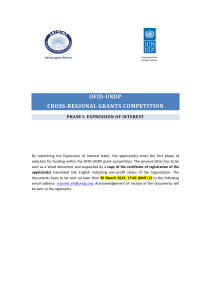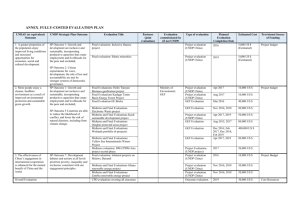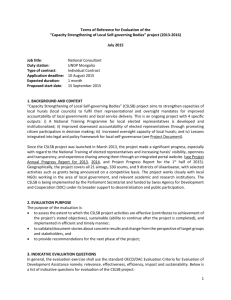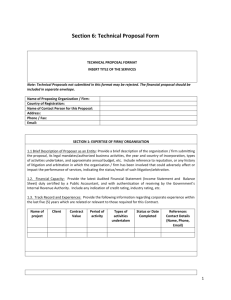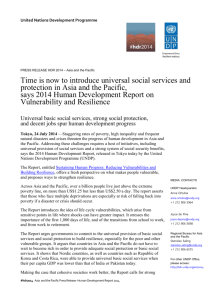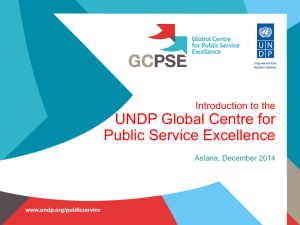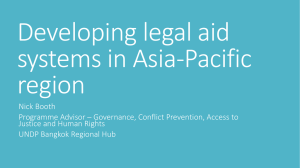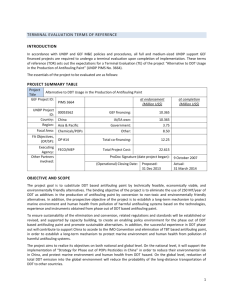Terminal Evaluation Terms of Reference
advertisement
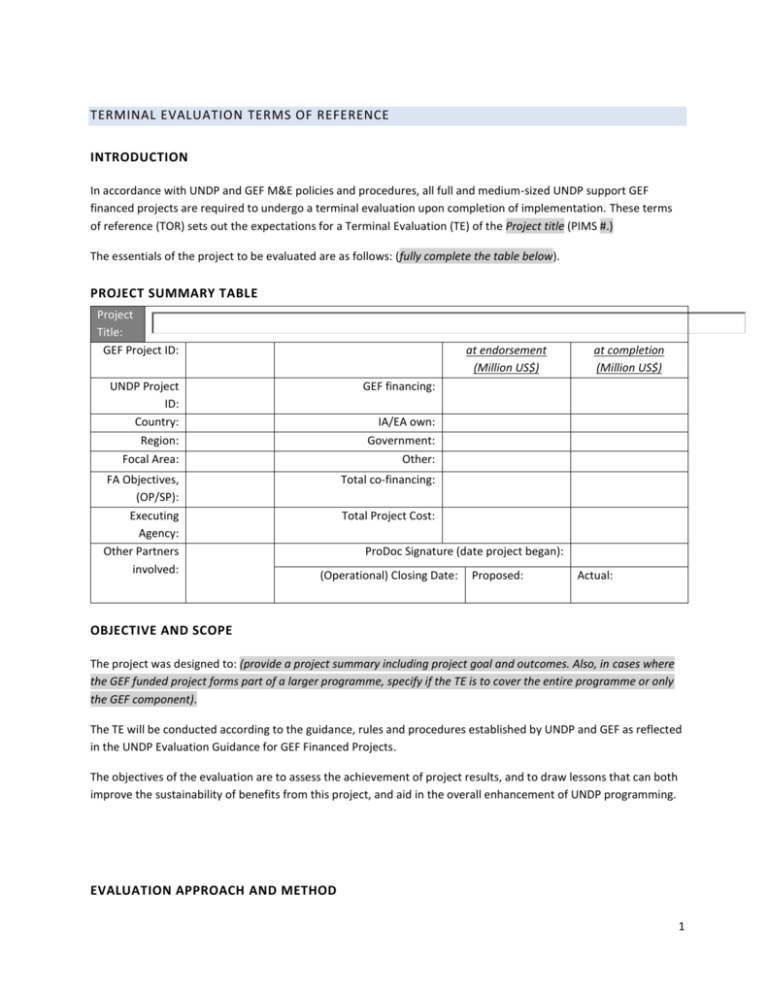
TERMINAL EVALUATION TERMS OF REFERENCE INTRODUCTION In accordance with UNDP and GEF M&E policies and procedures, all full and medium-sized UNDP support GEF financed projects are required to undergo a terminal evaluation upon completion of implementation. These terms of reference (TOR) sets out the expectations for a Terminal Evaluation (TE) of the Project title (PIMS #.) The essentials of the project to be evaluated are as follows: (fully complete the table below). PROJECT SUMMARY TABLE Project Title: GEF Project ID: at endorsement (Million US$) UNDP Project ID: Country: Region: GEF financing: Focal Area: Other: FA Objectives, (OP/SP): Executing Agency: Other Partners involved: Total co-financing: at completion (Million US$) IA/EA own: Government: Total Project Cost: ProDoc Signature (date project began): (Operational) Closing Date: Proposed: Actual: OBJECTIVE AND SCOPE The project was designed to: (provide a project summary including project goal and outcomes. Also, in cases where the GEF funded project forms part of a larger programme, specify if the TE is to cover the entire programme or only the GEF component). The TE will be conducted according to the guidance, rules and procedures established by UNDP and GEF as reflected in the UNDP Evaluation Guidance for GEF Financed Projects. The objectives of the evaluation are to assess the achievement of project results, and to draw lessons that can both improve the sustainability of benefits from this project, and aid in the overall enhancement of UNDP programming. EVALUATION APPROACH AND METHOD 1 An overall approach and method1 for conducting project terminal evaluations of UNDP supported GEF financed projects has developed over time. The evaluator is expected to frame the evaluation effort using the criteria of relevance, effectiveness, efficiency, sustainability, and impact, as defined and explained in the UNDP Guidance for Conducting Terminal Evaluations of UNDP-supported, GEF-financed Projects. A set of questions covering each of these criteria have been drafted and are included with this TOR (fill in Annex C) The evaluator is expected to amend, complete and submit this matrix as part of an evaluation inception report, and shall include it as an annex to the final report. The evaluation must provide evidence‐based information that is credible, reliable and useful. The evaluator is expected to follow a participatory and consultative approach ensuring close engagement with government counterparts, in particular the GEF operational focal point, UNDP Country Office, project team, UNDP GEF Technical Adviser based in the region and key stakeholders. The evaluator is expected to conduct a field mission to (location), including the following project sites (list). Interviews will be held with the following organizations and individuals at a minimum: (list key stakeholders). The evaluator will review all relevant sources of information, such as the project document, project reports – including Annual APR/PIR, project budget revisions, midterm review, progress reports, GEF focal area tracking tools, project files, national strategic and legal documents, and any other materials that the evaluator considers useful for this evidence-based assessment. A list of documents that the project team will provide to the evaluator for review is included in Annex B of this Terms of Reference. EVALUATION CRITERIA & RATINGS An assessment of project performance will be carried out, based against expectations set out in the Project Logical Framework/Results Framework (see Annex A), which provides performance and impact indicators for project implementation along with their corresponding means of verification . The evaluation will at a minimum cover the criteria of: relevance, effectiveness, efficiency, sustainability and impact. Ratings must be provided on the following performance criteria. The completed table must be included in the evaluation executive summary. The obligatory rating scales are included in Annex D. Evaluation Ratings: 1. Monitoring and Evaluation M&E design at entry M&E Plan Implementation Overall quality of M&E 3. Assessment of Outcomes Relevance Effectiveness Efficiency Overall Project Outcome Rating rating rating 2. IA& EA Execution Quality of UNDP Implementation Quality of Execution - Executing Agency Overall quality of Implementation / Execution 4. Sustainability Financial resources: Socio-political: Institutional framework and governance: Environmental : Overall likelihood of sustainability: rating rating PROJECT FINANCE / COFINANCE 1 For additional information on methods, see the Handbook on Planning, Monitoring and Evaluating for Development Results, Chapter 7, pg. 163 2 The Evaluation will assess the key financial aspects of the project, including the extent of co-financing planned and realized. Project cost and funding data will be required, including annual expenditures. Variances between planned and actual expenditures will need to be assessed and explained. Results from recent financial audits, as available, should be taken into consideration. The evaluator(s) will receive assistance from the Country Office (CO) and Project Team to obtain financial data in order to complete the co-financing table below, which will be included in the terminal evaluation report. Co-financing (type/source) UNDP own financing (mill. US$) Planned Actual Government (mill. US$) Planned Actual Partner Agency (mill. US$) Planned Actual Total (mill. US$) Actual Actual Grants Loans/Concessions In-kind support Other Totals MAINSTREAMING UNDP supported GEF financed projects are key components in UNDP country programming, as well as regional and global programmes. The evaluation will assess the extent to which the project was successfully mainstreamed with other UNDP priorities, including poverty alleviation, improved governance, the prevention and recovery from natural disasters, and gender. IMPACT The evaluators will assess the extent to which the project is achieving impacts or progressing towards the achievement of impacts. Key findings that should be brought out in the evaluations include whether the project has demonstrated: a) verifiable improvements in ecological status, b) verifiable reductions in stress on ecological systems, and/or c) demonstrated progress towards these impact achievements.2 CONCLUSIONS, RECOMMENDATIONS & LESSONS The evaluation report must include a chapter providing a set of conclusions, recommendations and lessons. IMPLEMENTATION ARRANGEMENTS The principal responsibility for managing this evaluation resides with the UNDP CO in (include Country name).The UNDP CO will contract the evaluators and ensure the timely provision of per diems and travel arrangements within the country for the evaluation team. The Project Team will be responsible for liaising with the Evaluators team to set up stakeholder interviews, arrange field visits, coordinate with the Government etc. 2 A useful tool for gauging progress to impact is the Review of Outcomes to Impacts (ROtI) method developed by the GEF Evaluation Office: ROTI Handbook 2009 3 EVALUATION TIMEFRAME The total duration of the evaluation will be XX days according to the following plan: Activity Timing Preparation Evaluation Mission Draft Evaluation Report Final Report XX days (recommended: 2-4) XX days (r: 7-15) XX days (r: 5-10) XX days (r;: 1-2) Completion Date date date date date EVALUATION DELIVERABLES The evaluation team is expected to deliver the following: Deliverable Inception Report Presentation Draft Final Report Final Report* Content Timing Responsibilities Evaluator provides clarifications on timing and method Initial Findings Full report, (per annexed template) with annexes Revised report No later than 2 weeks before the evaluation mission. Evaluator submits to UNDP CO End of evaluation mission Within 3 weeks of the evaluation mission Within 1 week of receiving UNDP comments on draft To project management, UNDP CO Sent to CO, reviewed by RTA, PCU, GEF OFPs Sent to CO for uploading to UNDP ERC. *When submitting the final evaluation report, the evaluator is required also to provide an 'audit trail', detailing how all received comments have (and have not) been addressed in the final evaluation report. TEAM COMPOSITION The evaluation team will be composed of (1-2 international /national evaluators). The consultants shall have prior experience in evaluating similar projects. Experience with GEF financed projects is an advantage. (If the team has more than 1 evaluator, one will be designated as the team leader and will be responsible for finalizing the report).The evaluators selected should not have participated in the project preparation and/or implementation and should not have conflict of interest with project related activities. The Team members must present the following qualifications: Minimum XX years of relevant professional experience Knowledge of UNDP and GEF Previous experience with results‐based monitoring and evaluation methodologies; Technical knowledge in the targeted focal area(s) (additional skills based on project particulars) 4 EVALUATOR ETHICS Evaluation consultants will be held to the highest ethical standards and are required to sign a Code of Conduct (Annex E) upon acceptance of the assignment. UNDP evaluations are conducted in accordance with the principles outlined in the UNEG 'Ethical Guidelines for Evaluations' PAYMENT MODALITIES AND SPECIFICATIONS (this payment schedule is indicative, to be filled in by the CO and UNDP GEF Technical Adviser based on their standard procurement procedures) % 10% 40% 50% Milestone At contract signing Following submission and approval of the 1ST draft terminal evaluation report Following submission and approval (UNDP-CO and UNDP RTA) of the final terminal evaluation report APPLICATION PROCESS Applicants are requested to apply online (indicate the site, such as http://jobs.undp.org, etc.) by (date). Individual consultants are invited to submit applications together with their CV for these positions. The application should contain a current and complete C.V. in English (Spanish in LAC, French in Francophone Africa, etc.) with indication of the e‐mail and phone contact. Shortlisted candidates will be requested to submit a price offer indicating the total cost of the assignment (including daily fee, per diem and travel costs). UNDP applies a fair and transparent selection process that will take into account the competencies/skills of the applicants as well as their financial proposals. Qualified women and members of social minorities are encouraged to apply. 5 ANNEX A: PROJECT LOGICAL FRAMEWORK (to be added) ANNEX B: LIST OF DOCUMENTS TO BE REVIEWED BY THE EVALUATORS (to be added 6 ANNEX C: EVALUATION QUESTIONS This is a generic list, to be further detailed with more specific questions by CO and UNDP GEF Technical Adviser based on the particulars of the project. Evaluative Criteria Questions Indicators Sources Methodology Relevance: How does the project relate to the main objectives of the GEF focal area, and to the environment and development priorities at the local, regional and national levels? Effectiveness: To what extent have the expected outcomes and objectives of the project been achieved? Efficiency: Was the project implemented efficiently, in-line with international and national norms and standards? Sustainability: To what extent are there financial, institutional, social-economic, and/or environmental risks to sustaining long-term project results? Impact: Are there indications that the project has contributed to, or enabled progress toward, reduced environmental stress and/or improved ecological status? 7 ANNEX D: RATING SCALES Ratings for Outcomes, Effectiveness, Efficiency, M&E, I&E Execution 6: Highly Satisfactory (HS): no shortcomings 5: Satisfactory (S): minor shortcomings 4: Moderately Satisfactory (MS) 3. Moderately Unsatisfactory (MU): significant shortcomings 2. Unsatisfactory (U): major problems 1. Highly Unsatisfactory (HU): severe problems Sustainability ratings: Relevance ratings 4. Likely (L): negligible risks to sustainability 3. Moderately Likely (ML):moderate risks 2. Relevant (R) 1.. Not relevant (NR) 2. Moderately Unlikely (MU): significant risks 1. Unlikely (U): severe risks Impact Ratings: 3. Significant (S) 2. Minimal (M) 1. Negligible (N) Additional ratings where relevant: Not Applicable (N/A) Unable to Assess (U/A 8 ANNEX E: EVALUATION CONSULTANT CODE OF CONDUCT AND AGREEMENT FORM Evaluators: 1. 2. 3. 4. 5. 6. 7. Must present information that is complete and fair in its assessment of strengths and weaknesses so that decisions or actions taken are well founded. Must disclose the full set of evaluation findings along with information on their limitations and have this accessible to all affected by the evaluation with expressed legal rights to receive results. Should protect the anonymity and confidentiality of individual informants. They should provide maximum notice, minimize demands on time, and respect people’s right not to engage. Evaluators must respect people’s right to provide information in confidence, and must ensure that sensitive information cannot be traced to its source. Evaluators are not expected to evaluate individuals, and must balance an evaluation of management functions with this general principle. Sometimes uncover evidence of wrongdoing while conducting evaluations. Such cases must be reported discreetly to the appropriate investigative body. Evaluators should consult with other relevant oversight entities when there is any doubt about if and how issues should be reported. Should be sensitive to beliefs, manners and customs and act with integrity and honesty in their relations with all stakeholders. In line with the UN Universal Declaration of Human Rights, evaluators must be sensitive to and address issues of discrimination and gender equality. They should avoid offending the dignity and self-respect of those persons with whom they come in contact in the course of the evaluation. Knowing that evaluation might negatively affect the interests of some stakeholders, evaluators should conduct the evaluation and communicate its purpose and results in a way that clearly respects the stakeholders’ dignity and self-worth. Are responsible for their performance and their product(s). They are responsible for the clear, accurate and fair written and/or oral presentation of study imitations, findings and recommendations. Should reflect sound accounting procedures and be prudent in using the resources of the evaluation. Evaluation Consultant Agreement Form3 Agreement to abide by the Code of Conduct for Evaluation in the UN System Name of Consultant: __ _________________________________________________ Name of Consultancy Organization (where relevant): ________________________ I confirm that I have received and understood and will abide by the United Nations Code of Conduct for Evaluation. Signed at place on date Signature: ________________________________________ 3www.unevaluation.org/unegcodeofconduct 9 ANNEX F: EVALUATION REPORT OUTLINE 4 i. ii. iii. 1. 2. 3. 3.1 3.2 4The Opening page: Title of UNDP supported GEF financed project UNDP and GEF project ID#s. Evaluation time frame and date of evaluation report Region and countries included in the project GEF Operational Program/Strategic Program Implementing Partner and other project partners Evaluation team members Acknowledgements Executive Summary Project Summary Table Project Description (brief) Evaluation Rating Table Summary of conclusions, recommendations and lessons Acronyms and Abbreviations (See: UNDP Editorial Manual5) Introduction Purpose of the evaluation Scope & Methodology Structure of the evaluation report Project description and development context Project start and duration Problems that the project sought to address Immediate and development objectives of the project Baseline Indicators established Main stakeholders Expected Results Findings (In addition to a descriptive assessment, all criteria marked with (*) must be rated 6) Project Design / Formulation Analysis of LFA/Results Framework (Project logic /strategy; Indicators) Assumptions and Risks Lessons from other relevant projects (e.g., same focal area) incorporated into project design Planned stakeholder participation Replication approach UNDP comparative advantage Linkages between project and other interventions within the sector Management arrangements Project Implementation Adaptive management (changes to the project design and project outputs during implementation) Partnership arrangements (with relevant stakeholders involved in the country/region) Feedback from M&E activities used for adaptive management Report length should not exceed 40 pages in total (not including annexes). 5 UNDP Style Manual, Office of Communications, Partnerships Bureau, updated November 2008 6 Using a six-point rating scale: 6: Highly Satisfactory, 5: Satisfactory, 4: Marginally Satisfactory, 3: Marginally Unsatisfactory, 2: Unsatisfactory and 1: Highly Unsatisfactory, see section 3.5, page 37 for ratings explanations. 10 3.3 4. 5. Project Finance: Monitoring and evaluation: design at entry and implementation (*) UNDP and Implementing Partner implementation / execution (*) coordination, and operational issues Project Results Overall results (attainment of objectives) (*) Relevance(*) Effectiveness & Efficiency (*) Country ownership Mainstreaming Sustainability (*) Impact Conclusions, Recommendations & Lessons Corrective actions for the design, implementation, monitoring and evaluation of the project Actions to follow up or reinforce initial benefits from the project Proposals for future directions underlining main objectives Best and worst practices in addressing issues relating to relevance, performance and success Annexes ToR Itinerary List of persons interviewed Summary of field visits List of documents reviewed Evaluation Question Matrix Questionnaire used and summary of results Evaluation Consultant Agreement Form 11 ANNEX G: EVALUATION REPORT CLEARANCE FORM (to be completed by CO and UNDP GEF Technical Adviser based in the region and included in the final document) Evaluation Report Reviewed and Cleared by UNDP Country Office Name: ___________________________________________________ Signature: ______________________________ Date: _________________________________ UNDP GEF RTA Name: ___________________________________________________ Signature: ______________________________ Date: _________________________________ 12
